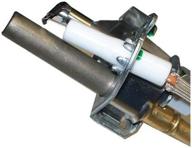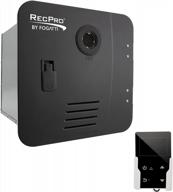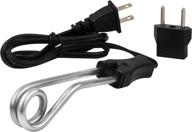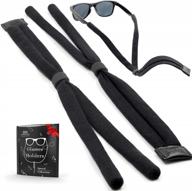
Review on 🚰 Ecosmart ECO Electric Tankless Water Heater - 27KW, 240V, 112.5 Amps - Patented Self Modulating Technology - White by Aaron Long

Details ECO27 and conversion to boiler operation - detail
Some information on this unit (and the entire product line) is scarce and many people have posted inaccurate information as well. First RTFM. EcoSmart provides a wealth of information on the internet and it would be good for all of us to check their website before posting inaccurate information. I have two of these units, one for hot water (hot water) and the other to control a baseboard for hot water throughout the house. System. Some information is difficult to find, and other information is closely guarded secrets and cannot be found anywhere on the internet. I will focus on these areas. The device is designed for 27 kW at 240 volts. Inside are three separate 9kW heaters that work in series and in series as needed. The device is truly self-modulating, generating no more heat than the load requires. Each individual heater requires a separate 240 circuit rated at 40 amps connected to wire #8. For Ohm's Law fans, each unit draws 37.5 amps at full load, for a total system load of 112.5 amps. Anyone attempting to run this unit from a 100 amp main circuit breaker deserves what they are getting. Our heater is plugged into our main 150 volt outlet and we can get away with that because everything else in the house is 'green' and we can run everything else on the available 37.5 amps when the heater is running at full load. I'll say it again, each indoor unit requires a separate, dedicated 240 volt 40 amp circuit, so a total of three separate 240 volt circuits using #8 wire. I hope I've explained this simply enough. The heat exchangers inside the heater are 3 copper tubes connected criss-cross in series with sections of copper about 1/2 inch in diameter. Thus there is a flow limitation, but not as drastic as in some test reports. I wish we could believe it. Some reviewers have written that their hot water drops to a trickle. I walked this unit from top to bottom. If your hot water is just dripping, it's time to clean pipes or replace valves. We have not observed any loss of flow anywhere in our house and enough has been said about that. The upper temperature limit is 140 degrees Fahrenheit. , 140 is a hard cap in hot water mode. It's not a device restriction, it's a security restriction to minimize the chance of someone getting scalded, and EcoSmart claims this on all their websites. supports water heating and even provides diagrams. However, they will not tell you how to get 160 or 180 degree water. The heater has internal jumpers that allow you to limit the maximum outlet temperature to 105 degrees (handy for the elderly or when small children are playing with a handle) and you can also set a power limit for 3 heating elements. Elements. Factory setting: 9 kW per element and max. 140 degrees. Exit. At the top of the sweater is a stripe that reads '180'. With the unit powered off, place a jumper across these two pins and the unit will allow the setpoint to be adjusted to 180 degrees when power is restored. Set 200 degrees. It is clear that a 140 degree ceiling heater can cause most baseboard hot water systems and many new hydraulic systems to perform poorly. We replaced an old oil boiler with an ECO27 and initially ran the set at 160. The performance is nothing short of amazing and I actually ran the set down to 150 by the time we hit the dead of winter. It's very nice to know that we have a reserve. EcoSmart provides extensive information about the capabilities of this device. I keep seeing that people can't (or don't want to) engage with a lot of what's publicly available. Simply put, if you need 4 gallons per minute, the best this unit can do is heat the water to 46 degrees. In other words, if you want a 110 degree shower (at a ridiculous 4 gallons per minute) you need to have at least 64 degrees incoming water. If you live in an area where your water source is around 50 degrees, you'll get a 96-degree shower at a rate of 4 gallons per minute. The obvious solution is to spend $20 and get a low flow shower head. At 3 GPM, this device can give you a 110 degree shower with only 49 degrees incoming water. At a flow rate of 2 GPM, this unit will provide a full setpoint of 140 degrees with an inlet water temperature of 50 degrees. If you are working with a boiler to get water with a temperature of 160 degrees, the incoming water must be at least 114 degrees. Most water heating systems work with a temperature difference of less than 20 degrees, so this device just stands around and provides 160 degree water for your baseboards. In addition, most standard water heating systems have a capacity of 1 or 4 GPM. The EcoSmart temperature rise chart shows that a temperature rise of 184 degrees at a rate of 1 gallon per minute is possible. Again, most hot water systems operate with a differential (or "Delta-T") of around 17 degrees and often less. The actual temperature set point is not as important as the ability to maintain the differential. So to reach 180 degrees, we need to feed the heater with water at a temperature of 163 degrees. At just 17 degrees elevation, this heater can easily flow well over 6 GPM, maybe closer to 10 GPM, but we only need 4 gallons per minute max. So for boiler maintenance this is the ideal solution. It's small, quiet and intelligent. If you are considering this unit for a hot water border or hydraulic operation, it can generate 92,000 Btu/hr. It has been misrepresented as the largest electric tankless available. The largest publicly available electric tankless output is 36 kW. Just to clarify. Overall I give this device 5 stars. Price, reliability and technical support at altitude. With professional installation, the device is covered by a lifetime warranty. Cleaning and maintenance is done with a Phillips screwdriver, no more fiddling with pipe wrenches and fiberglass insulation. The device is so small and light that I actually carried it into the house under my arm, set it up and said nothing. No one knew I had made it until a few days later! The device supports a remote thermostat, which is very inexpensive and waterproof. The small remote control connects to a phone cord and is ideal for placing next to a sink or shower. In a family of 3 adults, we use all the 'normal' things, laundry, shower, washing dishes, etc. to intentionally overshoot the heater by wide-open tub. In any other situation, two showers at the same time, someone in the shower, someone else doing laundry, etc. I haven't heard a single complaint. All I've ever heard is how great it is to take a long shower or not wait 1/2 hour etc. The days my wife complained about no hot water for the dishes because I took a long shower , are over! is a true self-modulating unit. People reporting flickering lights and TV problems should check the wiring in their home. The device begins to work quietly, as if a dimmer was turned on. There are no blinking lights in this house. The only way I could tell if a device was working was to look at it. The display is only illuminated when the device is in operation. Energy savings should not be neglected. The tank heater works around the clock to keep the tank warm even on vacation. Tankless does absolutely nothing unless it detects water flow. Thanks to their intelligent design, EcoSmart devices ignore faucet leaks and do not direct hot water to dripping faucets. The minimum flow rate to start the device is 1/4 GPM. I hope this helps eliminate misinformation and post accurate information. David.
- Number of switches required: three 40 amp double pole
- Fits
New products
Comments (0)
Top products in 🚿 Water Heaters & Parts

🔧 DIY Water Heater Sediment Cleaning Tool - Turbo Tank Cleaner for Hard Water

8 Review

🔥 Reliance Water Heater 9007876 Gas Thermopile Assembly - Reliable and Efficient Heating Solution, Pack of 1

9 Review

RecPro RV Tankless Water Heater: On Demand Hot Water, Gas-Powered & Remote Control - Black

23 Review

🌡️ Diximus 300W Dual Voltage Portable Immersion Water Heater - Fast Electric Boiler + Travel Pouch

8 Review
Another interesting products

Adult Shooting Ear Protection Earmuffs - Noise Cancelling Safety Ear Muffs For Hearing Reduction

26 Review

Unclog With Ease: Flexible Toilet Grabber Tool With 4 Jaws And Stainless Steel Pole

41 Review

2 Long Eyeglass Chains For Men And Women - SIGONNA Eyeglasses String Holder Strap Chain - Neck Retainer For Eye Glasses And Sunglasses - Rope Lanyard - 2 Pack In Black

39 Review

Flame And Heat Resistant Leather Welding Sleeves For Enhanced Arm Protection - Suitable For Men And Women

32 Review

